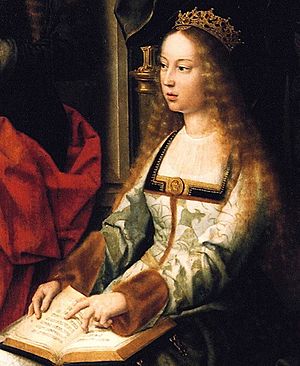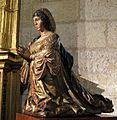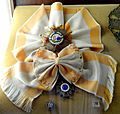Isabella of Castile facts for kids
Quick facts for kids Isabella I |
|||||||||||||||
|---|---|---|---|---|---|---|---|---|---|---|---|---|---|---|---|

Isabella I of Castile, painted in the Virgen de la mosca at The Collegiate church of Santa María la Mayor
|
|||||||||||||||
| Queen of Castile and León | |||||||||||||||
| Reign | 11 December 1474 – 26 November 1504 | ||||||||||||||
| Coronation | 13 December 1474 | ||||||||||||||
| Predecessor | Henry IV | ||||||||||||||
| Successor | Joanna | ||||||||||||||
| Co-monarch | Ferdinand V | ||||||||||||||
|
Queen consort of Aragon
----
|
|||||||||||||||
| Tenure | 20 January 1479 – 26 November 1504 | ||||||||||||||
| Born | 22 April 1451 Madrigal de las Altas Torres |
||||||||||||||
| Died | 26 November 1504 (aged 53) Medina del Campo |
||||||||||||||
| Burial | Royal Chapel of Granada | ||||||||||||||
| Spouse | Ferdinand II of Aragon | ||||||||||||||
| Issue Detail |
|||||||||||||||
| House | Trastámara | ||||||||||||||
| Father | John II of Castile | ||||||||||||||
| Mother | Isabella of Portugal | ||||||||||||||
| Religion | Roman Catholic | ||||||||||||||
| Signature | |||||||||||||||
Isabella I (born April 22, 1451 – died November 26, 1504) was a powerful queen. She ruled Castile from 1474 until her death. Her marriage to Ferdinand II of Aragon helped unite Spain. This union happened under their grandson, Charles I.
Isabella worked hard to claim her right to the throne. She then improved the government system. She also lowered crime rates and cleared the kingdom's huge debts. Her changes, along with those of her husband, had a big impact. Their influence reached far beyond their own kingdoms.
Isabella and Ferdinand are famous for finishing the Reconquista. This was a long period of Christian kingdoms taking back land from Muslim rule. They also told their Muslim and Jewish subjects to convert to Christianity or leave. They are also known for supporting Christopher Columbus. They paid for his 1492 voyage. This trip led to the discovery of the New World. It helped Spain become a major world power for over a century. Pope Alexander VI gave Isabella and Ferdinand the special title "the Catholic." The Catholic Church recognized Isabella as a Servant of God in 1974.
Contents
Early Life and Family
Isabella was born in Madrigal de las Altas Torres, Ávila, on April 22, 1451. Her parents were John II of Castile and his second wife, Isabella of Portugal. When she was born, Isabella was second in line to the throne. Her older half-brother, Henry IV of Castile, was first. Henry was 26 and married, but he had no children.
Isabella's younger brother, Alfonso of Castile, was born two years later. This made Isabella third in line to the throne. In 1454, her father died. Her half-brother became King Henry IV of Castile. King Henry was supposed to take care of Isabella and Alfonso.
Life in Arévalo
Isabella, her mother, and Alfonso moved to Arévalo. Life there was difficult for Isabella. Their castle was in poor condition, and they did not have much money. Her father's will said his children should be well cared for. However, King Henry did not follow these wishes. He might have wanted to keep his half-siblings restricted.
Even with tough living conditions, Isabella learned a lot. Her mother taught her about being religious and having deep respect for faith.
Life at Court
Later, King Henry's wife, Joan of Portugal, was about to have a daughter, Joanna. Isabella and Alfonso were called to court in Segovia. The King wanted to watch over them directly and make sure they finished their education. Alfonso was given a tutor. Isabella joined the Queen's household.
Life improved for Isabella in Segovia. She always had food and clothes. She lived in a beautiful castle decorated with gold and silver. Isabella's education included reading, writing, and math. She also learned art, chess, dancing, and music. She spent her free time with her ladies-in-waiting. They enjoyed art, embroidery, and music. She lived a relaxed life, but she rarely left Segovia. King Henry did not allow it. He kept her away from the political problems in the kingdom. However, Isabella knew exactly what was happening and her role in the royal disputes.
Marriage and Rule
Isabella's brother, Enrique IV, who was the King of Castile, wanted to arrange her marriage. Isabella wanted to marry someone from Portugal. This would create a political alliance. However, she secretly married Ferdinand II of Aragon in 1469. They had five children together. Their youngest daughter was Catherine of Aragon. Catherine later married Henry VIII of England in 1509. Isabella was also the grandmother of Carlos I of Spain, who became Charles V, Holy Roman Emperor.
When Isabella’s brother, King Enrique, died, Isabella was supposed to become queen. But Enrique's daughter, Juana, also wanted to be queen. After a war, Isabella became queen of Castile. At the same time, her husband, Ferdinand, became king of Aragon. They united the lands of Castile and Aragon. This union formed what is now modern-day Spain.
Isabella helped pay for four of Christopher Columbus’s trips. These trips were to find new routes to Asia. Instead, he reached the Americas. At that time, people called the Americas "The New World." In 1492, Isabella signed an agreement that made Spain a Christian country. After she died, her daughter Joanna of Castile became queen.
Images for kids
-
Statue of Isabella by Felipe Bigarny; it resides in the Capilla Real, in Granada.
-
Isabella I of Castile by Juan de Flandes (c. 1500–1504)
-
Queen Isabella ~ Christopher Columbus
Issue of 1893
See also
 In Spanish: Isabel I de Castilla para niños
In Spanish: Isabel I de Castilla para niños













